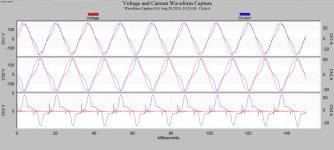bbwilson81
Member
- Location
- Iowa
- Occupation
- Engineer
I am hoping that someone here can help point me in the right direction. I collected power quality data at a newly constructed residence that is experiencing continuous pulsating LED lighting. There are many different brands and types of LED lighting throughout the home, some of which are unaffected. Looking at the standard line-to-neutral RMS voltage and current and voltage and current THD data points, the results appear to indicate that the incoming power is normal and within standards. Upon further investigation, the neutral-to-ground voltage and current (Ch3) was measured to reveal a 2V ringing transient that fires off on the voltage zero crossings. The monitor was set at the utility transformer, and the condition is present with and without the service connected. The utility changed out the transformer with to no avail and tested their driven ground at 7 ohms. Any gurus out there have any thoughts on the matter? The service is in a very low-density rural setting. The only unique condition is 2-2 MW wind turbines that are interconnected to the utility's distribution system a couple miles away although the homeowner advised that the condition is present even when the turbines are offline. Thanks! (ref. attached waveform)



